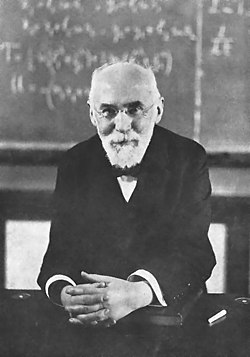Hendrik Lorentz
Hendrik Antoon Lorentz (18 July 1853 – 4 February 1928) was a Dutch physicist. In 1902, he was awarded the Nobel Prize in Physics together with Pieter Zeeman for the discovery and theoretical explanation of the Zeeman effect. He also derived the transformation equations that were later used by Albert Einstein to describe space and time.
Hendrik Antoon Lorentz | |
|---|---|
 | |
| Born | 18 July 1853 |
| Died | 4 February 1928 (aged 74) Haarlem, Netherlands |
| Nationality | Netherlands |
| Alma mater | University of Leiden |
| Known for | Lorentz transformation Theory of EM radiation Lorentz force Lorentz contraction |
| Awards | Nobel Prize for Physics (1902) Rumford Medal (1908) Franklin Medal (1917) Copley Medal (1918) |
| Scientific career | |
| Fields | Physics |
| Doctoral students | Geertruida L. de Haas-Lorentz Adriaan Fokker Leonard Ornstein Hendrika Johanna van Leeuwen |
Biography
Early life
Hendrik Lorentz was born in Arnhem, Gelderland (The Netherlands), the son of Gerrit Frederik Lorentz (1822–1893). In 1862, after his mother's death, his father married Luberta Hupkes.
Career
Lorentz and special relativity

In 1905, Einstein would use many of the concepts to write his paper entitled "On the Electrodynamics of Moving Bodies",[1] known today as the theory of special relativity. Because Lorentz laid the fundamentals for the work by Einstein, this theory was originally called the Lorentz-Einstein theory.[2]
Lorentz and general relativity
Lorentz was one of few scientists who supported Einstein's search for general relativity from the beginning – he wrote several research papers and discussed with Einstein personally and by letter.[3] For instance, he attempted to combine Einstein's formalism with Hamilton's principle (1915).
Death
In January 1928, Lorentz became seriously ill, and died shortly after on February 4.[4]
Hendrik Lorentz Media
Lorentz' theory of electrons. Formulas for the Lorentz force (I) and the Maxwell equations for the divergence of the electrical field E (II) and the magnetic field B (III), La théorie electromagnétique de Maxwell et son application aux corps mouvants, 1892, p. 451. V is the velocity of light.
Lorentz' theory of electrons. Formulas for the curl of the magnetic field (IV) and the electrical field E (V), La théorie electromagnétique de Maxwell et son application aux corps mouvants, 1892, p. 452
Lorentz (left) at the International Committee on Intellectual Cooperation of the League of Nations, here with Albert Einstein
His published university lectures in theoretical physics. Part 1. Stralingstheorie (1910–1911, Radiation theory) in Dutch, edited by his student A. D. Fokker, 1919.
Lorentz-monument Park Sonsbeek in Arnhem, the Netherlands
Related pages
References
- ↑ Einstein, Albert (1905), "Zur Elektrodynamik bewegter Körper" (PDF), Annalen der Physik, 322 (10): 891–921, Bibcode:1905AnP...322..891E, doi:10.1002/andp.19053221004. See also: English translation.
- ↑ Miller, Arthur I. (1981). Albert Einstein's special theory of relativity. Emergence (1905) and early interpretation (1905–1911). Reading: Addison–Wesley. ISBN 0-201-04679-2.
- ↑ Kox, A.J. (1993). "Einstein, Lorentz, Leiden and general relativity". Class. Quantum Grav. 10: S187–S191. Bibcode:1993CQGra..10S.187K. doi:10.1088/0264-9381/10/S/020. S2CID 250884975.
- ↑ Kox, Anne J. (2011). "Hendrik Antoon Lorentz (in Dutch)". Nederlands Tijdschirft voor Natuurkunde. 77 (12): 441.
Other websites
| Wikimedia Commons has media related to Lua error in Module:Commons_link at line 62: attempt to index field 'wikibase' (a nil value).. |
| Wikisource has original works written by or about: |
| German Wikisource has original writing related to this article: |







